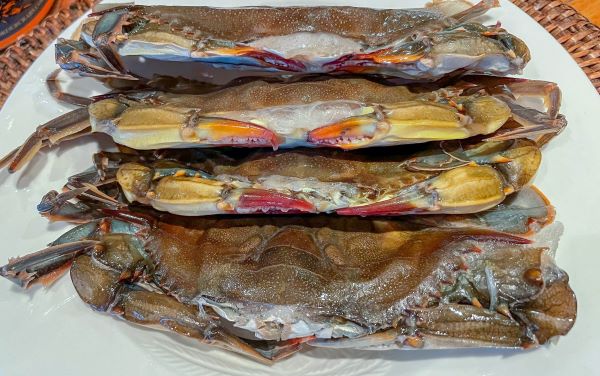What's a “Cleaned & Dressed” Soft Shell?


What does a “Cleaned & Dressed” Soft Shell mean?
Timing makes the soft shell experience perfect. First, know when the Chesapeake Bay Crabs burst from their shells to grow a new roomy one. The process is spectacular. The crab intakes mass amounts of water to bloat its body and in turn cracks the shell at “the hinges.” Then they back-step out of the old shell and search for eelgrass or oyster beds to hide as they lay naked and vulnerable. Other crabs or large fish, like red drum bass, find the meat as delicious as we do. Interesting fact, female sooks, however, receive an armed protector from her male mate as she waits for the new shell to grow. Crabbers keep an eye on the clock for about two hours. This short window in time for searching out a soft shell gives everyone a sense of urgency. Knowing where they hide, the months of May through September when they “molt” their shells, and a willingness to clean them motivate the crabber.
Sometimes the bountiful catch requires a keen eye. The crabber, after pulling in a hefty pot will notice a few crabs, slightly busting out of their shells or the “hinge” shows a reddening, forecasting a timely shedding of the old shell. So, secondly, the crabber must have knowledge of a soft shell’s development. In this case, the crabbers use a tank for these crabs, so they can become soft shells. They wait for them to bust and then it’s time to size them. Carefully measured, they fit in these categories: Mediums, 3.5”-4”, Hotels, 4”-4.5”, Primes, 4.5”-5”, Jumbos, 5”-5.5”, and Whales 5.5” plus. The smaller size works well with sandwiches, while the large “wow” on the plate as an entrée, but back to the catch.
Cleaning and dressing the soft shell may cause a novice to squirm a bit, but the crab is prepared while still alive and without any beginnings of a new shell. Third, the crabber must act decisively! Yes, timing is key. From each bin, the crabber grabs a soft shell, one at a time and with shears, cuts a line right behind the eyes. “Avoid looking at those beady eyes as you remove the crab’s face.” These crabbers grimace. “It will cause you to look at food as a pet. That never works.” The line should remove about a ¼ of the inedible month and eye parts. Then, they locate the bottom apron tab and pull up to expose the gills or dead man’s fingers. Some call them the crab lungs, but they certainly don’t taste good either. Once the crabber has cleaned out all the inedible innards, the dressing or pressing of the crab to stretch out is the final step. This process will present a soft shell ready for sauteing in garlic butter, deep frying for a taco, or beer battering for tempura. If the time isn’t right, a flash-freezing will ensure the soft shell awaits your cooking calendar convenience.
Return back to the MD Soft Shell page.




